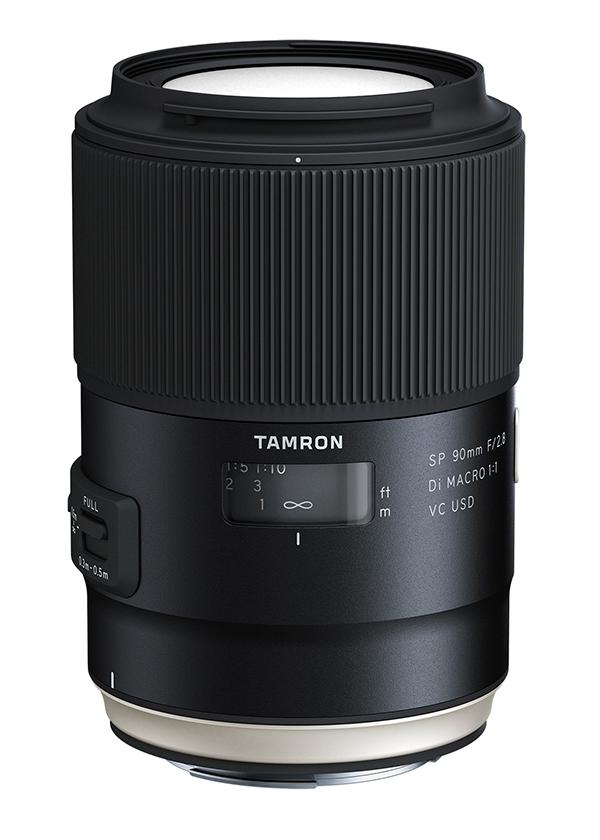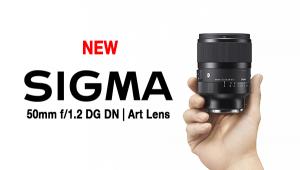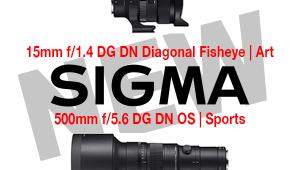Tamron Unveils 90mm F/2.8 Macro Lens with Revamped VC Image Stabilization Tech

Tamron unveiled another new lens this morning: the SP 90mm F/2.8 Di VC USD 1:1 MACRO (Model F017). The new SP 90mm F/2.8 Di VC USD 1:1 MACRO (Model F017) is the follow-up to the Tamron 90mm f/2.8 Di Macro from 2012, and has been updated with several key features.
The announcement of the new Tamron SP 90mm F/2.8 Di VC USD 1:1 MACRO follows the unveiling of another new piece of glass from Tamron this morning: the SP 85mm F/1.8 Di VC USD (Model F016) lens.
With the new 90mm F/2.8 Di VC USD 1:1 MACRO, Tamron has added XY-Shift compensation to its VC (Vibration Compensation) tech in the lens, which is designed to further improve image stabilization from infinity to macro. Advancements in USD control software have also increased AF focusing speed, and optimally fine-tuned for various framing conditions, Tamron said in a press announcement this morning.
In addition, a new moisture-proof and dust-resistant build has been added to prevent intrusion of dust or moisture, and a durable Fluorine Coating has been applied to the top element surface to prevent condensation and repel smudge-causing substances.
The SP 90mm F/2.8 Di VC USD 1:1 MACRO lens will be on sale in the U.S. starting in March 2016 in Canon and Nikon mounts (the Sony mount to be launched at a later date).
The on-sale date in the USA is February 25, 2016 at an approximate price of $649.
Here’s rundown of the key specs for the new Tamron SP 90mm F/2.8 Di VC USD 1:1 MACRO lens, from Tamron’s press announcement this morning.
“1. Built upon the outstanding optical performance of the legendary Tamron 90mm Macro
Inheriting the optical design of the previous 90mm Macro lens (Model F004), the new Model F017 delivers the same excellent resolving power and remarkably soft background blur effects (bokeh). The advanced construction includes one LD (Low Dispersion) specialized glass element that maximally limits the dispersion properties of light and two XLD (eXtra Low Dispersion) glass elements that correct dispersion properties to an even greater extent. The special elements optimally compensate for on-axis and lateral chromatic aberrations from macro shooting range to infinity. Furthermore, the design ensures the best imaging performance at any range by adopting the Floating System that shifts the location of a group of elements to the best possible position as the focusing group travels relative to shooting distances. From 1:1, life-size close-ups to the most distant horizon, this new 90mm Macro lens achieves outstanding image quality.2. Optimized for spectacular background blur effects (bokeh)
Earlier models of Tamron’s 90mm macro lens received high acclaim for their spectacular blur effects, and the new 90mm macro builds upon this legacy. To continue this commitment, thorough optical simulations were conducted. Careful examinations were performed to minimize any blurring with a doubled image appearing for a single line because that phenomenon has a considerably negative impact on background image quality. As a result, the lens achieves both sharp, vivid images and spectacular background blur effects. This combination is highly prized by portrait photographers.3. VC enhanced with shift compensation
An accelerometer has been integrated into Tamron’s highly accredited VC (Vibration Compensation) to compensate for shakes on the x-y plane. In unison with a gyro sensor, the accelerometer detects and enables motion compensation for camera shake, providing maximum efficiency in image stabilization optimized for all distance ranges from infinity to macro.4. USD actuator maximized for macro photography is fast, accurate and quiet
The control software program for the USD (Ultrasonic Silent Drive) actuator has been revised to provide substantially improved focusing speed and accuracy when using AF. The USD quickly addresses any out-of-focus condition caused by back-and-forth camera movement (which commonly occurs during macro photography) ensuring better results when shooting at close range.5. Moisture-Proof and Dust-Resistant Construction
Special seals protect areas of possible ingress surrounding switches, and the boundary between the focus ring and the lens barrel. These provide stronger protection against the intrusion of dirt, dust and moisture compared to the Moisture-Resistant Construction used previously. This additional protection assures even more wide-ranging opportunities for using this lens.6. A durable Fluorine Coating on the front element repels water and fingerprints
The water and oil repellant coating applied to the front element surface allows instant removal of dirt or smudges with ease. The coating also provides a reasonable level of durability, and will sustain its effectiveness for years. The Fluorine Coating technology that Tamron developed for use in industrial optics applications was first used on the SP 15-30mm that was introduced in 2014.7. Advanced coating technology reduces flare and ghosting
Two advanced coating technologies, both providing outstanding anti-reflection performance, are applied to critical element surfaces for maximum light transmission. eBAND (Extended Bandwidth & Angular-Dependency) Coating boasts outstanding anti-reflection performance across nearly the entire range of visible rays, and BBAR (Broad-Band Anti-Reflection) Coating utilizes traditional multi-layered, anti-reflection technology. This combination virtually eliminates extraneous reflections and substantially reduces ghosting and flare which enables the lens to achieve flawless, crystal clear images.8. Use of circular aperture to achieve beautiful, rounded blur effects (bokeh)
When shooting a scene that includes a point-source of light in the subject background, marvelously tuned blur (bokeh) can be obtained without generating undesirable polygonal shapes of aperture patterns thanks to the circular aperture. The 9-blade diaphragm retains a nearly perfect circular opening even when stopped down by two stops.9. Focusing options perfectly suited to a macro lens
The new 90mm macro has a focus limiter that makes it possible to shorten the time for accurately focusing on a subject when the working range is known. The lens also features an Internal Focusing system, so the overall length of the lens never changes, not even when focusing. As a result, the user is assured of a comfortable working distance of at least 139 mm (5.5 in.) from the front of the lens. In addition, the lens is equipped with a Full-time Manual Focus override mechanism that makes it possible to flexibly choose focal points. Even with the AF driving system in action, it is possible to instantaneously override it to make manual fine focusing adjustments without switching the AF-MF mode back and forth.10. Compatibility with TAMRON TAP-in Console
Always as new as tomorrow: You can update firmware, customize autofocus positions and adjust the mechanical setup and preferences of the 90mm lens by simply attaching it to the TAMRON TAP-in Console™ and connecting it via USB to a personal computer. (The TAP-in Console™ is an optional accessory that will be released in March.)11. Digital image editing software optimized for Tamron lenses
Included in the new 90mm macro package is SILKYPIX Developer Studio, a popular RAW conversion and editing program preloaded with correction menus for various aberrations based on the optical data that pertains exclusively to Tamron’s SP Series lenses. In addition, lens profile information has been supplied to Adobe Systems, Inc. to facilitate selecting the precise lens data required for more sophisticated adjustments in RAW processing when using Adobe Photoshop and Lightroom.Tamron and the history of its macro lenses
The history of Tamron’s macro lenses began with the SP AF90mm F/2.5 (Model 52B) in 1979. The general impression of a macro lens in those days was that it was mainly useful for academic purposes—such as reproducing documentary records and scientific minutiae—and not suitable for photographing ordinary subjects. Against this backdrop, Tamron’s first-generation 90mm macro lens succeeded in creating new value for the modern macro lens that has both refined image quality worthy of recording photographic scenes and remarkably beautiful background blur effects (bokeh). As a result, the lens was highly valued by professional and amateur photographers alike as a lens with wide-ranging uses. It created new categories of applications that previously had been unimaginable because of the common uses of macro lenses at the time. The lens became popular among nature photographers to shoot close-ups of flowers. Furthermore, using Tamron’s 90mm macro lens for portrait photography gained particular popularity, with the expression “portrait macro lens” coming to be widely recognized over time. With the model renewal in this latest generation achieving further performance improvements, SP 90mm F/2.8 Di MACRO 1:1 VC USD (Model F017) is opening a new chapter in the history of Tamron’s 90mm macro lenses.Design Concept
Beginning with the SP 35mm F/1.8 Di VC USD (Model F012) and SP 45mm F/1.8 Di VC USD (Model F013), Tamron has utilized a new design concept to enhance the outstanding performance provided by the SP Series. Our attention to every engineering detail has resulted in the most advanced optical and electro-mechanical designs being incorporated in SP Series, creating a new benchmark for high performance and visual elegance. The design philosophy embraces the importance of comfortable, ergonomic operation and positive tactile feedback, crucial factors in all types of photography. The newly designed all-metallic barrel features an embedded concave ring at the base of the lens—for a firm hold and comfort necessary for a steady shot. Switches are larger and reconfigured for smoother function and the typeface has been redesigned for intuitive legibility. The Tamron SP Series is the superlative example of the Lensmaker’s art.”
- Log in or register to post comments

















































